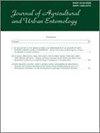尼日利亚一些本土树种对白蚁的抗性研究
Q2 Agricultural and Biological Sciences
The Journal of Agricultural and Urban Entomology
Pub Date : 2017-04-05
DOI:10.3954/1523-5475-33.1.10
引用次数: 7
摘要
摘要调查了尼日利亚翁多州一些本土树种对白蚁(bltodea: Termitidae)的抗性。本研究使用的不同体积密度的本土树木是Celtis zenkeri Engl。(大麻科);Albizia lebbeckBenth。(蚕豆科),蕨尾草。与Diels (combretacae), Cola gigantia . Chev。(malvacae)和Terminalia ivorensis A. Chev。(使君子科)。研究中使用的三个地点分别是Okitipupa, Akure和Akungba-Akoko,分别代表低地雨林,热带雨林和草原地区。在Okitipupa、Akure和Akungba-Akoko发现的主要白蚁种分别为Macrotermes bellicosus (Smeathman)、Macrotermes sybhylinus (Rambur)和Odontotermes horni (Wasmann)。每个地点的实地暴露试验表明,密度影响木材样品对白蚁攻击的抵抗力。高密度类木材比低密度类木材具有更好的抗白蚁攻击能力。阿库雷地区的袭击严重程度最高,奥基提帕地区的袭击严重程度最低。无论木材密度和位置如何,尼日利亚木材应在安装前进行处理,以确保保护。本文章由计算机程序翻译,如有差异,请以英文原文为准。
Resistance of Some Indigenous Tree Species to Termite Attack in Nigeria1
Abstract The resistance of some indigenous types of tree species to attack by termites (Blattodea: Termitidae) was investigated in Ondo State, Nigeria. Indigenous trees of different bulk densities used for this study were Celtis zenkeri Engl. (Cannabaceae), Albizia lebbeck (L.) Benth. (Fabaceae), Terminalia superba Engl. & Diels (Combretaceae), Cola gigantia A. Chev. (Malvaceae), and Terminalia ivorensis A. Chev. (Combretaceae). The three locations used for the study were Okitipupa, Akure, and Akungba-Akoko, representing lowland rainforest, tropical rainforest, and savannah regions, respectively. The primary termite species recovered were Macrotermes bellicosus (Smeathman), Macrotermes sybhylinus (Rambur), and Odontotermes horni (Wasmann) for Okitipupa, Akure, and Akungba-Akoko, respectively. Field-exposure tests for each of the locations suggested that density affected the resistance of the wood samples to termite attack. Wood in the high density class had a better resistance to attack by termites compared with low density wood. The severity of attack was highest in Akure and least in the Okitipupa location. Irrespective of wood density and location in Ondo State, Nigerian lumber should be treated before installation to ensure protection.
求助全文
通过发布文献求助,成功后即可免费获取论文全文。
去求助
来源期刊

The Journal of Agricultural and Urban Entomology
Agricultural and Biological Sciences-Insect Science
CiteScore
1.40
自引率
0.00%
发文量
2
期刊介绍:
The Journal of Agricultural and Urban Entomology (JAUE) (Journal of Agricultural Entomology, Jan 1984 - Oct 1998 volumes 1-15) is published under the auspices of the South Carolina Entomological Society (SCES). The Journal publishes contributions of original research concerning insects and other arthropods of agricultural and urban importance to include those affecting humans, livestock, poultry, and wildlife. JAUE is particularly dedicated to the publication of articles and notes pertaining to applied entomology, although it will accept suitable contributions of a fundamental nature related to agricultural and urban entomology.
 求助内容:
求助内容: 应助结果提醒方式:
应助结果提醒方式:


